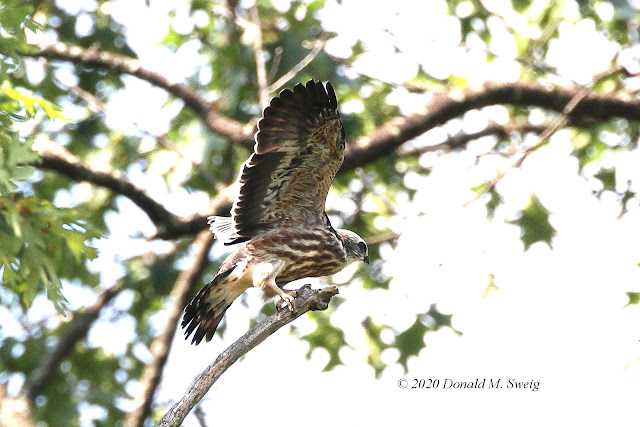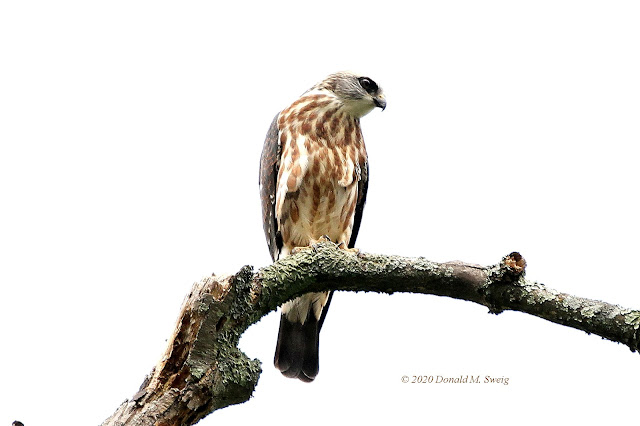PHOTO IMAGES:
MISSISSIPPI KITE NESTINGS IN NORTHERN VIRGINIA.
SPRING AND SUMMER 2017
I was privileged to be able to watch and photograph four Mississippi kite nestings in Northern Virginia in the Spring and Summer of 2017. The nest in Arlington Co. failed. The nesting pair near Backlick Rd. and Woodland Drive, in Fairfax County, produced at least one chick.
I watched and photographed the returning nesting pair from 2016, near the Greenspring Park in Fairfax Co., which fledged two chicks, regularly from mid-July until Labor Day. .
I also watched and photographed a new nesting location, near Monticello Park in Alexandria, which fledged one chick, from their return in May (when there were as many as six kites flying around the area together), through nest building and incubation, and as the chick grew and fledged.
I have posted 46 of these images below. Twenty-three from the Greenspring nesting, followed by twenty-three from the Alexandria/Monticello nesting.
I will say, however, that for me, as nice as the nests and chicks were to watch, the real thrill was watching these beautiful and elegant birds fly, dive, and hunt.
I'm already looking forward to next year.
THE GREENSPRING NESTING
Chicks in nest, on July 22nd.
Fledged chick, Aug. 2nd
Fledged chick, Aug. 6th
Fledgling being fed, note cicada in adult's beak. August 2nd.
Four Images.
Fledged juvenile, Aug. 5th
Both fledged juveniles, Aug. 25th.
Adult kite with cicada
Adult kite with what appears to be a small bird.
Adult kite with cicada feeding juvenile. August 25th
Three images.
Another feeding of both juveniles from Aug. 25.
Three images
Below is one of my favorite images.
The juvenile is in a level power flight, with wings back
and the Alulas on the front of the wings up.
I have never seen a juvenile kite fly like this before.
August 25th.
This is the same juvenile soaring.
Adult with cicada for juvenile.
Feeding the juvenile, notice the large
green cicada in the adult's beak. August 13th.
Two images.
Perched adult Mississippi Kite.
July 23rd.
ALEXANDRIA NESTING
The images below are from the nesting near Monticello Park
in Alexandria. I was able to watch and photograph these birds
from soon after they arrived in early May.
Perched adult male Mississippi kite, May 22nd
As above.
Adult Kite in flight.
Notice the very long outer primary feathers and the rufous color
on both the upper and lower surface of the outer wing feathers.
May 29th.
Adult female Mississippi kite, June 10th.
Adult Mississippi Kite, male, I believe. June1st.
As above
Look carefully.
There are four Mississippi kites perched in this tree. May 24th
Sub-adult, second-year, Mississippi kite.
This bird has the body and wing plumage of an adult,
but retains the outer wing feathers and brown banded tail
of a juvenile. May 24th.
Detail from a larger image with six kites in the air. May 26th.
These are both sub-adult, second -year birds.
One can clearly see the adult body plumage on the lower bird,
and the brown, banded tails on both birds. The upper bird is
also undergoing heavy molt of the inner primary wing feathers.
Detail, as above, of two adult kites flying together. May 26th.
These are probably the same two birds that mated and nested .
Adult Mississippi kites mating/copulating, May 26th.
Three images .
Below, the male wraps his wings around female
at conclusion of copulation.
Adult kite, probably the male, during nest building, May 22.
Notice the red eyes.
Chick, on left , and adult kite, on right, in nest, July 14th
Mississippi kite chick in nest, July 14th
Developing, now juvenile kite, in nest July 30th.
Fledged and perched Juvenile kite. August 13th.
Juvenile kite with wings spread, August 13th.
Adult kite returning to feed juvenile, with prey in beak.
Image clearly shows the swept back wing posture, and also the raised Alulas, on the upper edge of the wing. Aug. 13th
Adult returning to nest with cicada for chick, July 16th
Notice the long, swept back wings.
The wings are so long that they extend beyond the tip of
the tail on perched birds.
Adult kite, appears to be the male, spreading its wings on
June 4th. Back lighting shows the deep rufous color in the
outer wing feathers.
Same bird, now perched on same branch, five minutes later.
THAT'S ALL FOR NOW.
Hoping they all return to nest again in 2018.




























































































